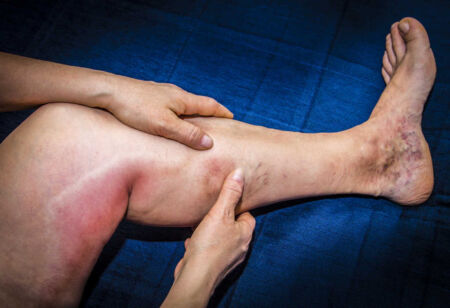
March has been designated Deep Vein Thrombosis Awareness Month. This month, learn more about this potentially life-threatening condition.
March is Deep Vein Thrombosis (DVT) Awareness Month — and for a good reason. The American Heart Association estimates DVT strikes between 300,000 and 600,000 people in the U.S. each year. While there are definite symptoms, many people aren’t able to recognize them and thus may be unaware they have DVT, a potentially life-threatening condition.
DVT materializes when a blood clot forms in a vein buried deep within the muscles. Although blood clots can develop wherever there is a deep vein in the body, DVT typically appears in the calf or thigh. When a DVT crops up in the leg, patients will notice pain, swelling, a feeling of warmth in the limb, red-colored skin, and that the area is sensitive to the touch.
However, the danger of DVT doesn’t end with those unpleasant symptoms. There’s risk that a blood clot in the leg may break free and travel to the lung, causing a pulmonary embolism. People who notice the signs of a pulmonary embolism occurring — chest pain, shortness of breath, rapid heart rate, and a bloody cough — should contact a doctor immediately.
Several factors put people at higher risk of DVT, including a family history of blood clots or DVT, extended bed rest after surgery, being overweight, and taking certain hormones. Having varicose veins is another risk factor. The good news? You can take measures to prevent DVT.
Maintain a healthy lifestyle. Incorporate regular exercise into your daily routine to keep your weight within a normal range and boost blood circulation. Low-impact exercises like walking, swimming, and bicycling are great for both your veins and your weight. In addition, you should limit your diet to low-fat, high-fiber foods like vegetables and fruit. Since smoking interferes with blood flow and increases the possibility of DVT, quit now. If you have hypertension, continue to take your blood pressure medication.
Stay safe when traveling. Sitting on a plane or in a car or train for long periods may promote the formation of DVT. On a trip longer than four hours, get up from your seat and move around frequently. Also, drink plenty of water, wear loose-fitting clothing, and slip on a pair of compression socks when you travel. Compression stockings are particularly important because the tight-fitting elastic pushes the blood from the legs to the heart.
Don’t be sedentary at work. The same rules apply when sitting at a desk as when you travel. Walk away from your desk periodically throughout the day, or perform simple stretching exercises such as curling and flexing your toes while seated. Crossing your legs tends to inhibit blood flow, so be careful not to cross your legs for very long while you sit at your desk.
Learn about DVT. Talk to your doctor about any conditions that could raise your risk of DVT, including varicose veins, chronic diseases like hypertension, and your family’s medical history in regards to blood clots. Know the symptoms of DVT so you’ll be able to contact your doctor for immediate treatment in case of emergency. If you’re at high risk, your doctor may prescribe blood thinners to block the growth of blood clots.
If you suffer from varicose veins and are concerned about DVT, the specialists at the Center for Vein Restoration can diagnose your condition and offer effective treatment options. Anyone experiencing the symptoms of DVT should contact our office today for an appointment. Don’t delay in getting therapy for this potentially serious ailment.